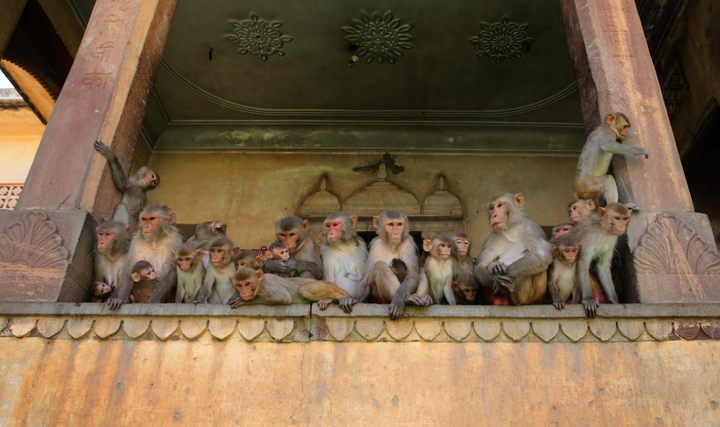
Can India Solve Its Macaque Conundrum With Contraception?
The science of controlling marauding, sacred monkeys, from the new book by best-selling author Mary Roach.
Excerpted and adapted from Fuzz: When Nature Breaks the Law, by Mary Roach, available September 14, 2021, from W.W. Norton.
The Wildlife Institute of India in Dehradun is a thrown-down cluster of concrete buildings connected by outdoor walkways. Because these corridors have no walls, rhesus monkeys from the neighboring forest can occasionally be seen walking along behind or beside the humans. Neither species pays the other much mind, as if the monkeys, too, have meetings to get to and photocopies to make. This nonchalant coexistence is in contrast to the state of human-monkey relations elsewhere in India.
“Simians Lay Siege to Agra,” blares a headline in the Times of India the week I arrive. It’s from a multi-feature full-spread special section, complete with signature two-color monkey menace graphic, the letter “O” taking the form of a fang-flashing monkey head. The lead story describes a baby fatally wounded after a rhesus macaque snatched him from his mother’s breast. “Earlier this month,” another Times piece states, “a bunch of monkeys had stoned a 72-year-old to death.” The National Herald has had Agra’s monkeys “in armies marching from one area to the other.” During the 11 months I’ve had Google on alert for monkey news in Delhi and Agra, Indian newspapers have reported eight lethal macaque “attacks.”
The past decade has seen a minor epidemic of people plummeting from balconies because of monkeys. I found news accounts of six deaths in the last three years alone. Most famously, there was the 2007 fall of Delhi deputy mayor S.S. Bajwa. While taking the air, Bajwa was startled by a group of macaques set on storming the house to look for food. As he tried to stop them—or get away from them (there were no eyewitnesses)—he lost his footing and hurtled over the railing.
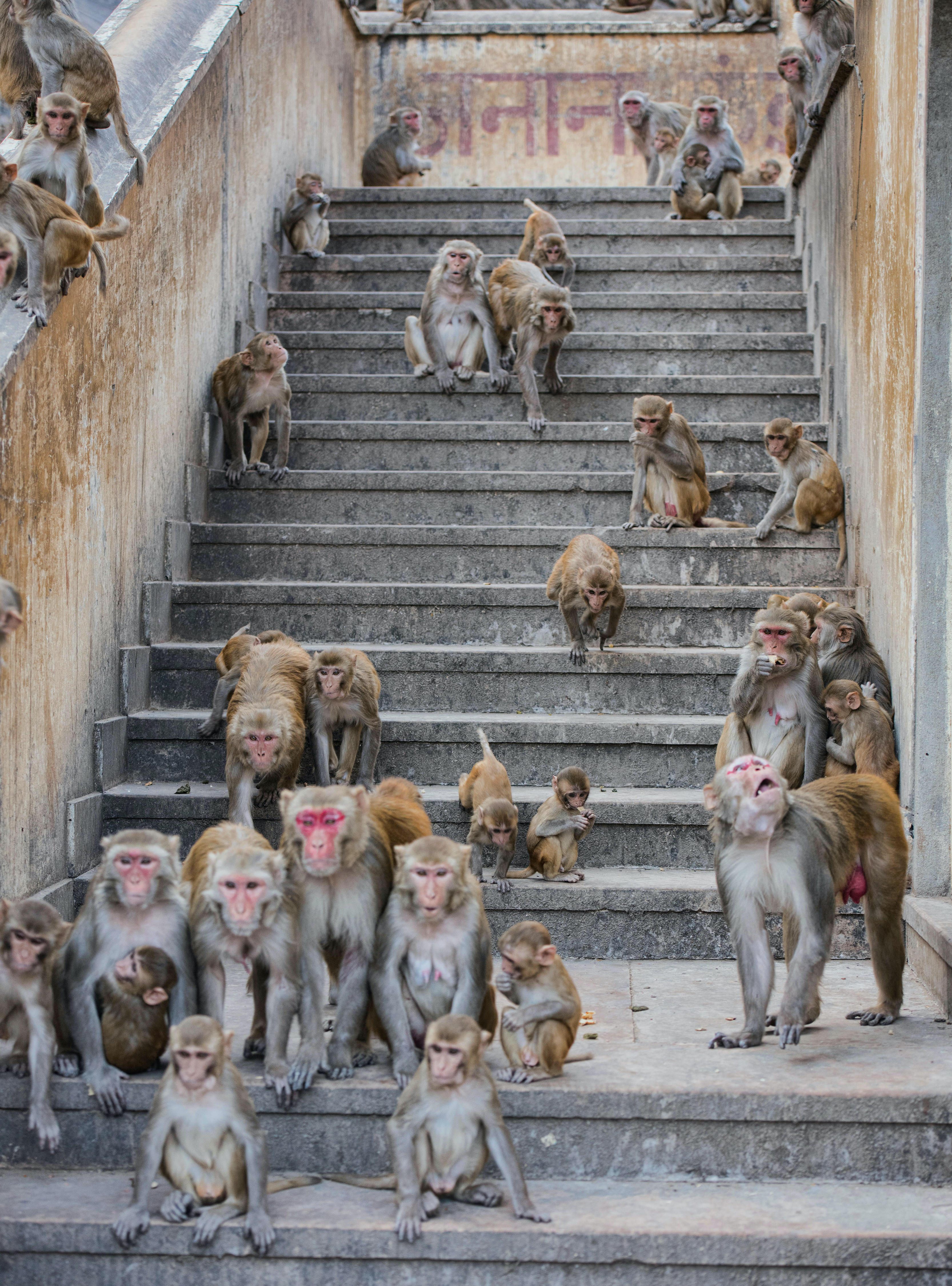
While I question the hostile intent that the word “attack” suggests, a monkey home invasion is surely an unnerving experience. Each evening on a recent visit to Udaipur, I would sit in one of the city’s many rooftop restaurants and watch langurs and macaques appear out of the dusk to begin their evening depredations. They sprinted up fire escapes and leaped from building to building like Tom Cruise in righteous pursuit. One night, making my way through an unmemorable dal, I looked up to see a langur vault onto a decorative beam above my table. Had the waiters not kept a stick close at hand for scaring off monkeys, the meal would quickly have become more memorable. When a 40-pound monkey abruptly drops in, you move without thinking. If you happen to be on a balcony or a roof, you too may shortly be dropping in from above.
The Wildlife Institute of India, according to several of these articles, is working on a contraceptive vaccine. The Times of India wrote of a shot that would “‘sterilise’ the animal within minutes.” Here is the dream! Easily administered, long-lasting birth control for overpopulous, problematic wildlife. Before leaving for India, I was unable to confirm an appointment date by email with Qamar Qureshi, the institute’s director of research, and he has been out for the Diwali holiday. Dipanjan Naha, a researcher with the institute I met earlier, agreed to escort me onto the grounds so I could pester the man in person.
It’s ten past nine on Monday morning. I’m waiting for Naha at the front gate. The guard wheels an office chair out into the sun for me. He is dressed in a uniform with a fringed hip sash and a magnificent red plumed beret, as though it were royalty under his protection, not wildlife biologists. Just past the gate there’s a small grounds building surrounded by chain-link fencing and topped with concertina wire. A macaque walks casually through the barbed loops.
Naha crosses the institute lawn to retrieve me. As we walk to the main building, he explains that Qureshi is in Monday morning meetings. He walks me to Qureshi’s office and promises to let him know I’m waiting.
Qureshi’s desk accessories are wildlife-themed—a zebra-stripe pencil cup, a tiger-stripe water bottle. To my left, a sliding glass door opens onto a terrace that, yes, macaques have twice used as an access point, ransacking desktops in a pandemonium of airborne papers and office supplies and then, finding nothing edible, dashing out the way they came. The incidents were related to me, mostly in pantomime, by a man who sits at a desk at the back of Qureshi’s office. He speaks no English, and his function is unclear to me. He wears a striped short-sleeved dress shirt and a vest, also striped. It’s all stripes all the time in here.

A secretary walks in and places two open file folders on Qureshi’s desk. Forms are flagged with Post-it notes. “Otherwise he will sign anywhere!” She laughs. “Does Sir know you’re here?”
“Oh, yes. He’s in a meeting.”
She makes an ominous clucking sound. “His meetings are indefinite. I wish you luck.” Behind her, the striped man is tilting into sleep. A macaque minces along the edge of a rooftop at the far side of the courtyard.
Qureshi arrives around 11:00, with a few of his researchers. He is lean and tall and has a warm, sociable demeanor. In place of a perfunctory “How are you,” he gives me “How are you finding India? How’s your tummy?”
Before delving into the science, we talk more generally about India and its animal predicaments. “The entire country is almost a sanctuary,” says Qureshi. He signs as he speaks, working his way through the Post-its. “In the sense that our laws are quite stringent.” Since the 1972 passage of the Wildlife (Protection) Act, it has been illegal to kill or capture wild animals without a permit or a state declaration that a particular species is “vermin.” Qureshi glances over the top of his reading glasses. “And people are for this.”
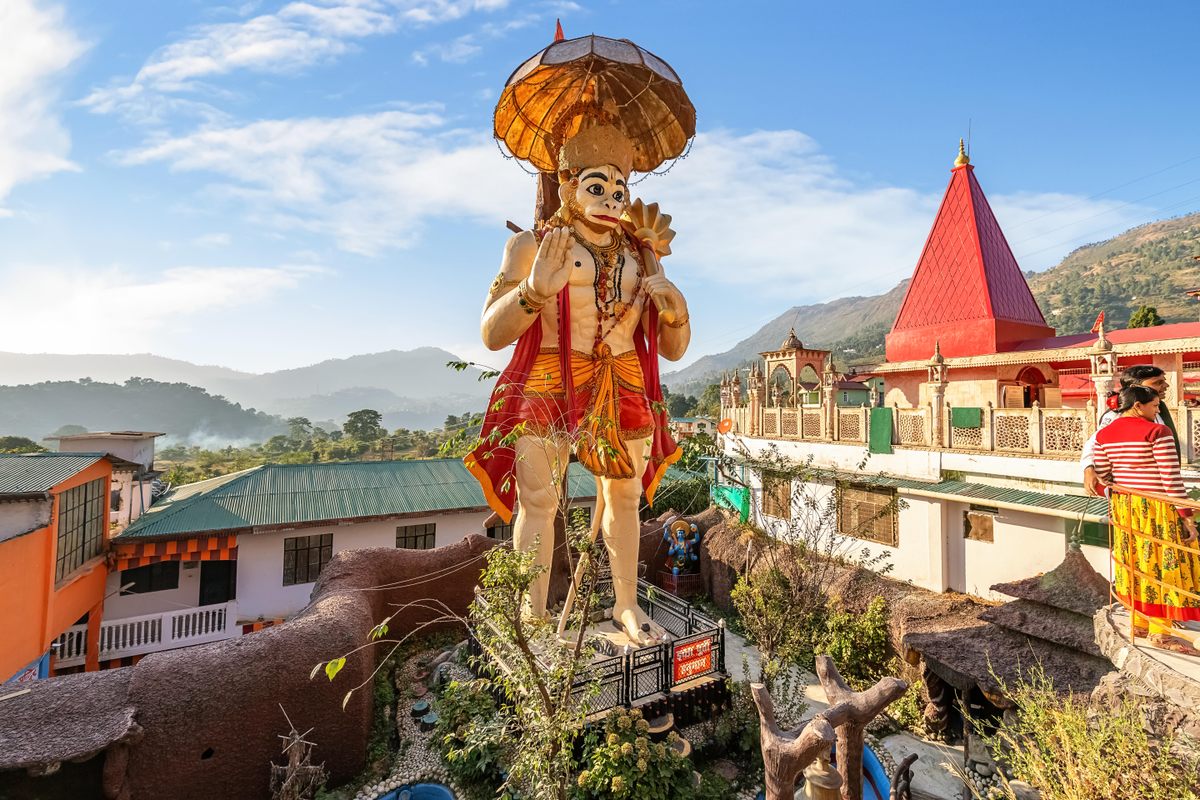
Hindu deities often take the form of an animal, or they are part animal, or parts of several animals, or their spouse is an animal, or they ride around on one. I share the story of my first visit to Delhi, when a live rat dropped from someplace above the sidewalk and landed on my foot. “You are blessed!” proclaimed the man I was walking with. “The rat is the conveyance of Lord Ganesha.”
Qureshi’s researchers have been listening intently. “Everything is a deity!” hoots a project fellow named Uddalak Bindhani. “Basil is a deity! It is one of Vishnu’s wives.”
“If you think about it,” says Divya Ramesh, a young behavioral ecologist with an easy smile and a pierced eyebrow, “it’s a really nice thing, because people have this great association with nature.”
But even Hindu tolerance has limits. Especially if the individual is a farmer. India’s top agricultural pests also happen to be sacred animals. Elephants represent the deity Ganesh, and monkeys, Hanuman. The wild boar is an avatar of Vishnu. The nilgai, or blue bull, is actually an antelope, but gai means cow, and cows are sacred. When state officials wanted to begin culling the animal, they first pushed through a name change. Nilgais are now roj, or “forest antelope.”
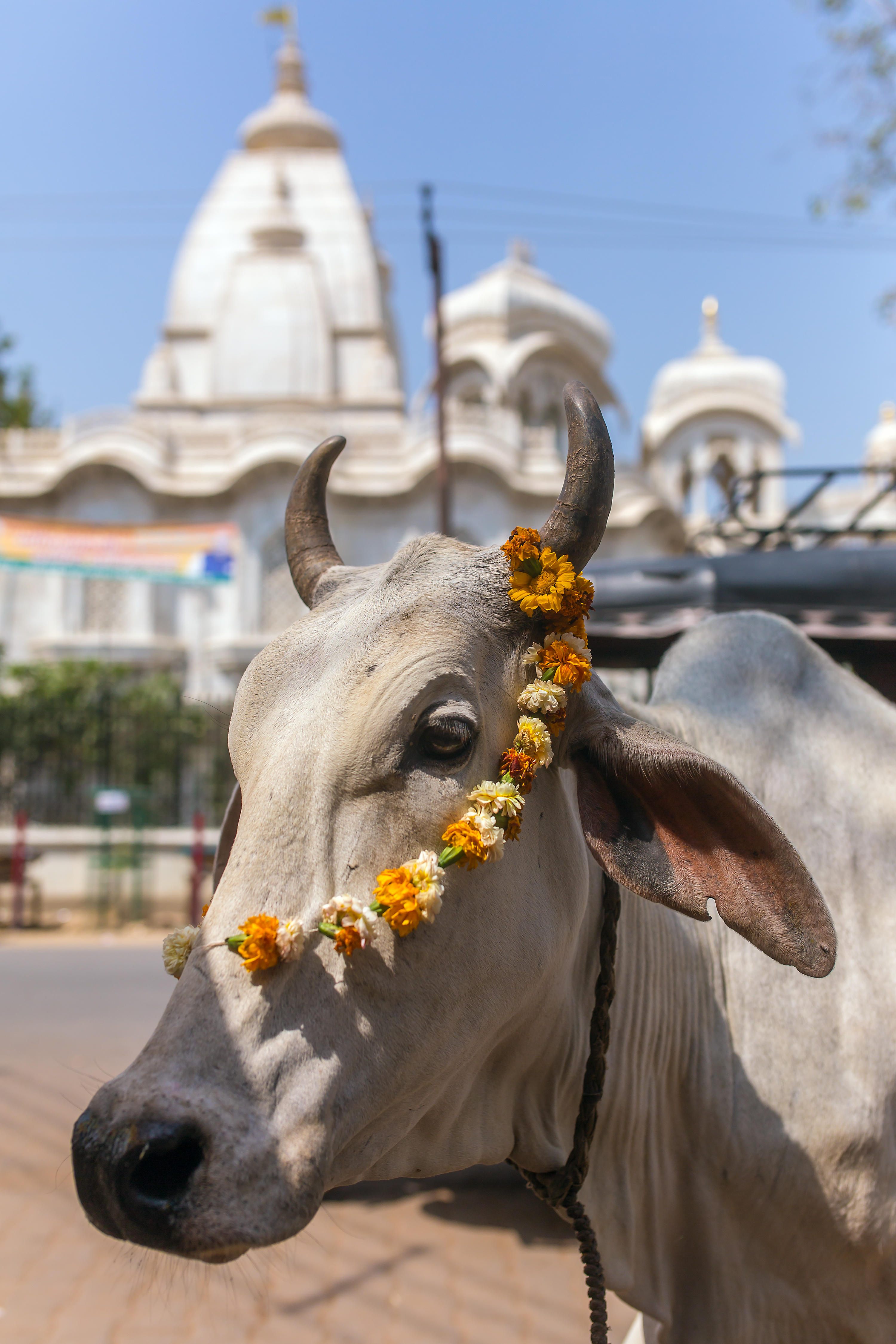
Despite the endlessly recurring “monkey menace” media froth, the government neither of Agra nor of Delhi has declared macaques vermin. And if they did, they’d be hard-pressed to find exterminators. “You’ll not find anyone to kill a monkey,” says Nilanjana Bhowmick, a Delhi-based journalist I’ve recently met. The Veterinary Services department of Delhi’s municipal government has a hard enough time finding people to catch macaques even just to relocate them, which is the current strategy. Even non-Hindus avoid the job, as monkey catchers are often harassed and threatened.
Deepening the problem: offerings. Tuesdays and Saturdays, devotees visit Hanuman temples to make a puja. To the icons inside, they present coconuts and garlands of marigolds; to the living representatives hanging around outside, samosas and Frooti mango pop. Feeding wild animals, as we know, is the quickest path to conflict. The promise of food motivates normally human-shy animals to take a risk. The risk-taking is rewarded, and the behavior escalates. Shyness becomes fearlessness, and fearlessness becomes aggression. If you don’t hand over the food you’re carrying, the monkey will grab it. If you try to hold onto it, or push the animal away, Qureshi says, it may slap you. Or bite you. The Times of India put the number of monkey bites reported by Delhi hospitals in 2018 at 950.
Qureshi recalls visiting a Hanuman temple in Himachal Pradesh, where he had gone for a wildlife meeting. His hosts warned him not to carry anything valuable, because the macaques would grab it to ransom for food. Qureshi left his phone and wallet locked in the glove compartment of his car. “This one guy came and—” Qureshi stands and pulls his pockets inside out. “Really! They put a hand in your pocket and properly search you!”
I have a macaque story too. Mine is set near Bundi, in Rajasthan, on a trail through the brush to the ruins of a 14th-century fort above the city. I knew there were monkeys up there, because their silhouettes are visible along the parapets at dusk. I went in the morning. I had bananas. I was asking for it. I wanted to know what it was like to be mugged by monkeys. My friend Steph followed behind to document the crime with a tightly clutched iPhone. The first shot is of me, looking down, preoccupied with my footing, orange plastic produce bag dangling from one hand. But look closer. A little tan head has popped up from behind a boulder farther down the trail. Out of the camera’s view, another monkey lurks. Outlaws lying in wait for the stagecoach. As I approach the boulder, the first macaque steps into view. While we stand there sizing each other up, the other one shoots out from behind me and grabs the bananas. Slick! I wouldn’t call it an attack. It was more of a purse-snatch, over too quickly to create any fear.
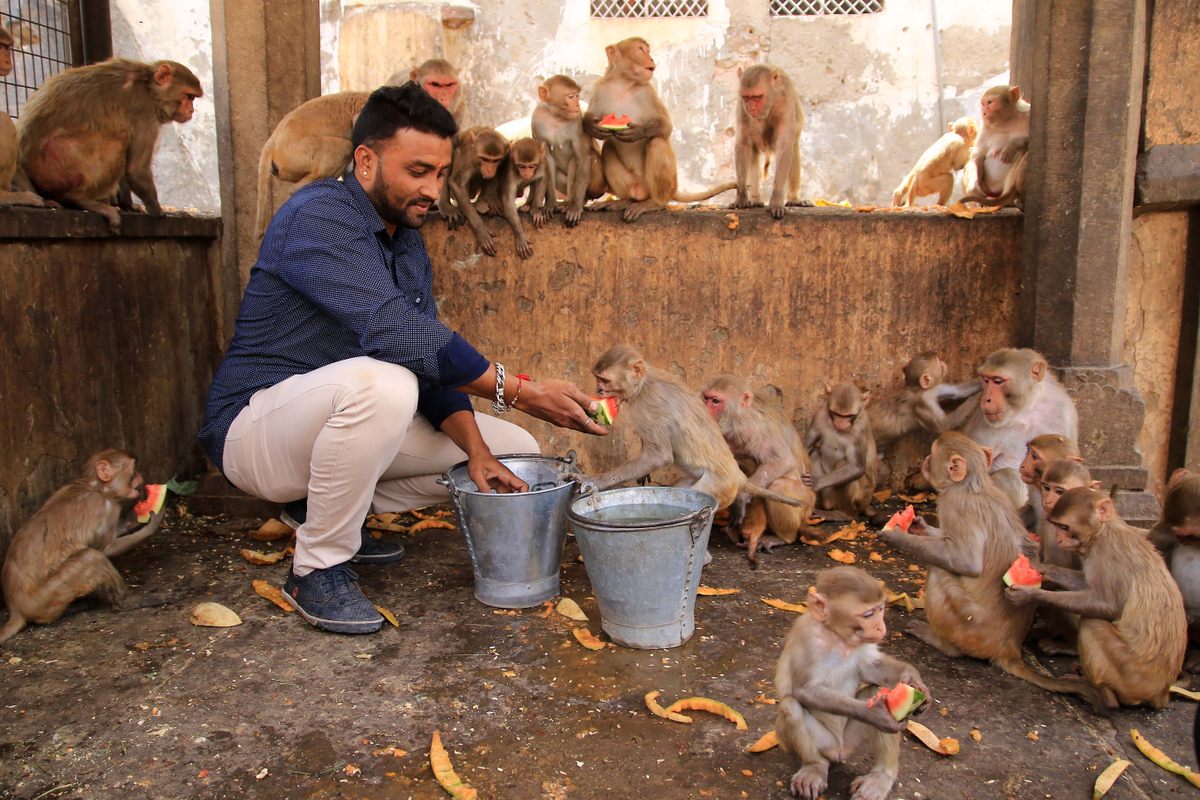
In 2008, the Delhi city government passed legislation prohibiting the feeding of wild monkeys, but according to one news story, no fines have been issued. Outside the Hanuman temple in Delhi’s Connaught Place, I watched a man approach a group of macaques. There was a side-glancing furtiveness to him, as if he were approaching sex workers, not monkeys. He quickly handed over a bag of tomatoes and watched as a portly female sat on her haunches, expertly freeing the pulp and sliming the pavement with the skins. A temple employee watched it happen but did nothing.
Because, Qureshi insists, the employee understands the importance of the gesture. “You want to go to heaven? Then you feed them. You want to book a berth, a nice house there? You feed.”
“And these are the same people,” adds Ramesh, “who are crying, ‘Get rid of these monkeys!’”
Qureshi closes a folder and sets down his pen. “Many people, when you interview them, they say, ‘Don’t kill them!’ They just want them to disappear.” It’s the same everywhere: wildlife NIMBYism. Squirrels in the park are adorable. Squirrels digging in your planters are deplorable.
Qureshi adds that the other problem with government-controlled culling—referring here to the shooting of wild boar and nilgais—is that while it is permissible to kill them, the law forbids eating the meat. “And here”—he means India—“you don’t kill a species for the sake of killing. Only a psychopath does that.”
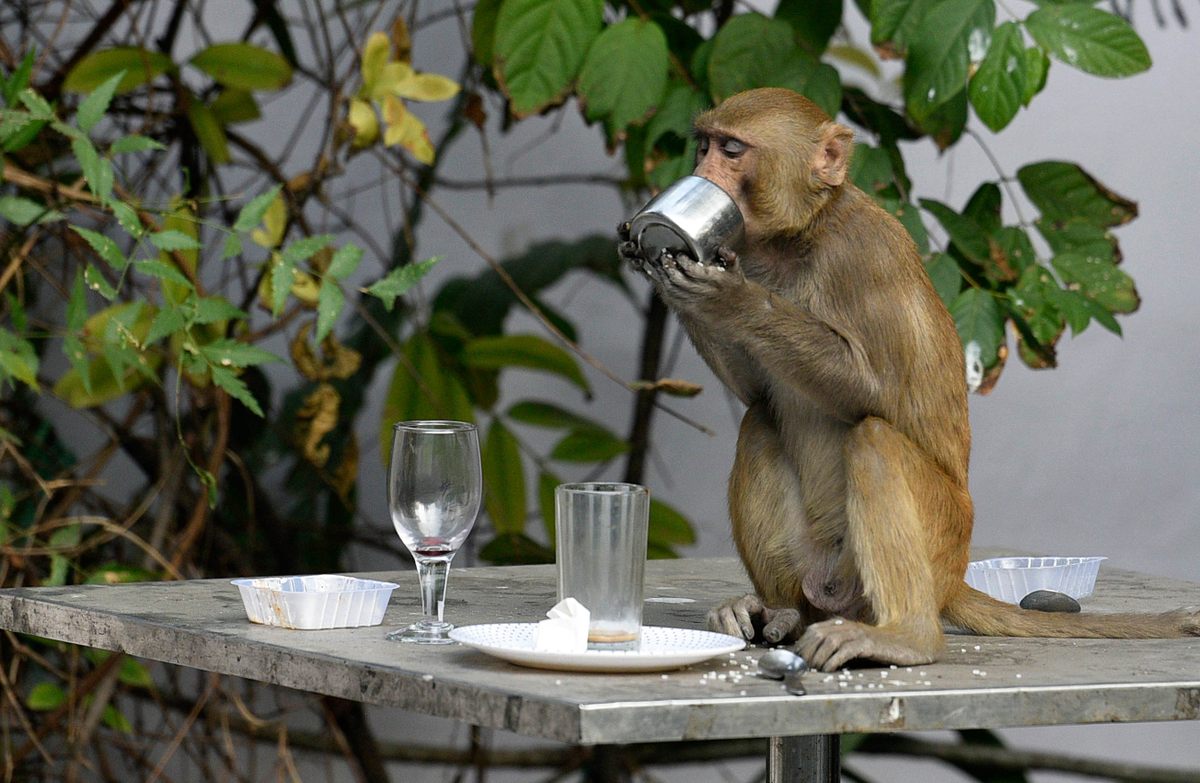
The great hope is that science will come up with a way to impose birth control on problem animals. It’s true that Qureshi’s team has been working on an immunocontraceptive vaccine for macaques, but it’s not true that it would render the animal sterile “within minutes,” as the Times of India reported. Nor would it be orally administered, as other news outlets have reported. Qureshi rests his elbows on the desk. “A birth control pill for monkeys is a far-fetched dream.” You’d need to make sure enough animals were eating enough of it on a regular basis and somehow prevent other species from doing the same.
Oral contraceptives are most practical in a controlled, single-species condition. Like a sewer. To control Norway rats, some U.S. cities have begun using an oral contraceptive called ContraPest, which relies on two active ingredients. The first, VCD (4-vinylcyclohexene diepoxide), depletes the ovaries of eggs. VCD began its career as an industrial plasticizer, but when human health and safety tests revealed it to be an endocrine disrupter, it was repurposed for rodent birth control. Because VCD takes time to work, a second compound was added, this one for the boys, too. Triptolide impacts sperm and egg viability for as long as the animals consume it. It’s not yet clear that the two together reliably confer permanent sterilization to a community of rats, but a few American cities are giving it a go. It would not, however, seem to be a solution for widely roaming monkeys with plentiful dining options.
The Wildlife Institute of India is running a trial of an injectable immunocontraceptive vaccine called PZP (porcine zona pellucida). The zona pellucida is a protein coat with sperm receptors that surrounds the egg. Give the female a vaccine of foreign (pig, say) zona pellucida and her immune system will be primed to make antibodies against her own zona pellucida. These antibodies glom onto the receptors, leaving sperm with no access to the egg. Fertilization stymied.
Logistical hurdles abound. Like many vaccines, PZP requires booster shots to keep the immune system on alert. This is, of course, a challenge with free-ranging animals. It’s time-consuming and costly enough to round up and inject a population of animals the first time around. Administering boosters adds to the time and expense, and on top of that you need some sort of permanent marking—a tattoo, say—to enable booster-givers to know who’s had the first shot and who has not.
In the United States, a synthesized zona pellucida has been tried—mainly on populations of geographically confined animals. The wild horses of Assateague Island were good candidates, because they move in herds and it’s a small island, so it’s relatively easy to give all the injections at one go. And then do it all over again in three to six weeks, after which a yearly booster seems to do the trick. For the tens of thousands of wild rhesus monkeys that roam Indian cities, it makes little sense even to try.
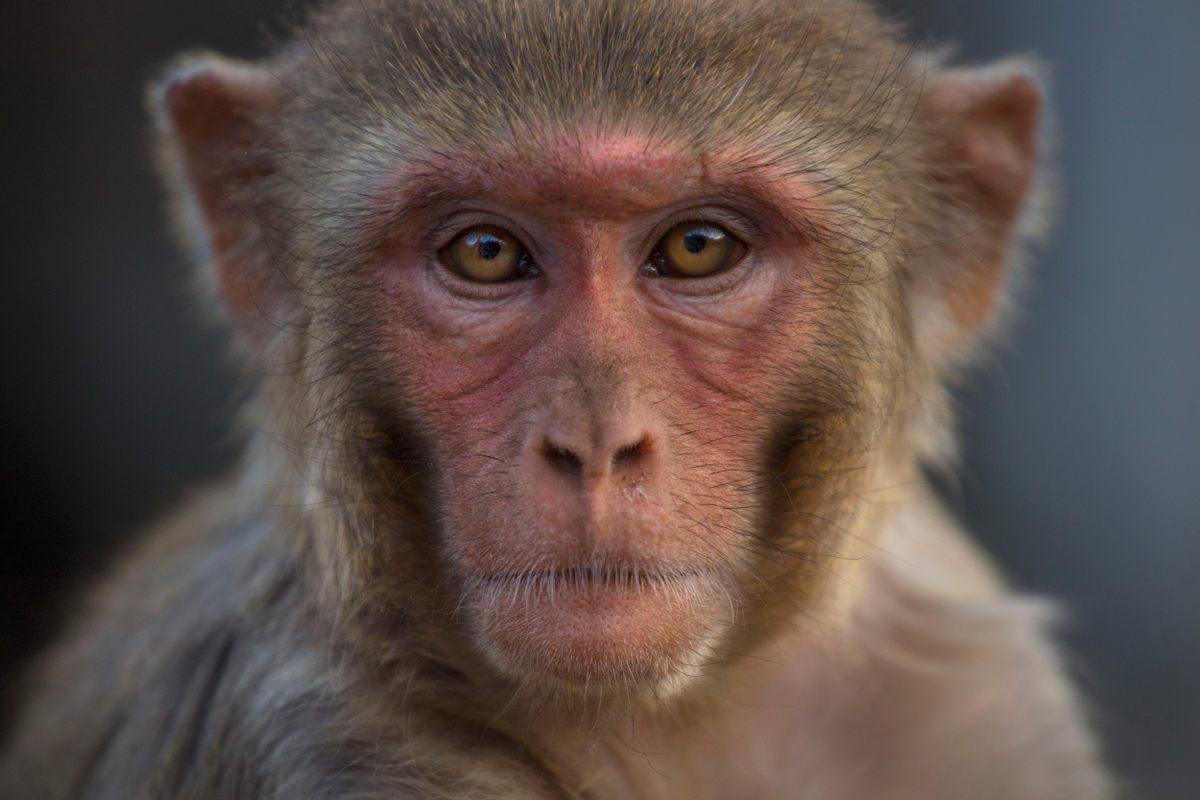
Here’s the other problem with zona pellucida vaccines for monkeys. Females that don’t become pregnant will quickly cycle into heat again, and each time they do, males will respond with breeding-season behavior. Meaning they’re more aggressive more of the time—not only toward other macaques but, it’s believed, toward humans. This happened with white-tailed deer in some U.S. trials of PZP. The bucks weren’t aggressive toward humans but they roamed around more, looking for sex, and their wanderings took them across roads and highways and that wasn’t good for deer or for drivers. Partly for this reason, immunocontraceptive research in the United States has focused on a vaccine that instead blocks the effects of sex hormones. GonaCon stops females from cycling. After an initial injection and a single booster shot, 92 percent of mares in North Dakota’s horse-dense Theodore Roosevelt National Park remain infertile seven years later. The study is ongoing and the hope is that infertility will prove to be permanent.
Is there any immunocontraceptive vaccine that might confer permanent sterility from a single shot? The National Wildlife Research Center and the U.S. Bureau of Land Management are currently testing one on a subset of a population of wild horses that has outgrown what its rangeland can support. The shot contains two active components (BMP-15 and GDF-9). Antibodies against these components hinder the egg’s ability to communicate with the cells that surround and support it, so it never matures. Because this vaccine wouldn’t require marking animals and tracking them down for a booster, it would seem to hold promise for treating urban macaques.
Qureshi sees a broader problem with immunocontraception, or any form of monkey contraception, for that matter. That is, people will expect the problem to start going away as soon as the treatment starts. “But you are not killing the animal,” he says. “They will live their life.” City macaques live 12 to 15 years. Qureshi estimates it would take seven or eight years before the population drops enough for the effects to become noticeable to the average macaque-aggrieved Indian. “People will say, ‘You spent all that money and the problem is not gone?’”



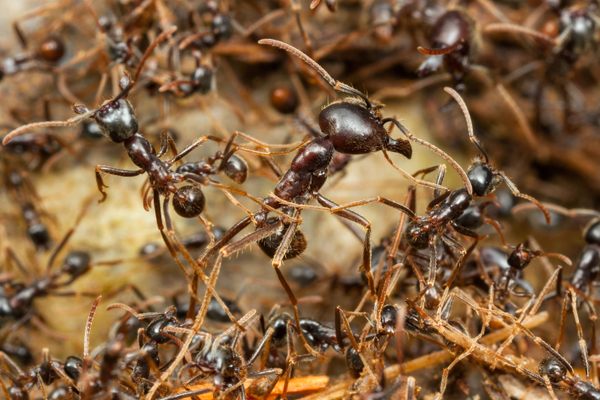




















Follow us on Twitter to get the latest on the world's hidden wonders.
Like us on Facebook to get the latest on the world's hidden wonders.
Follow us on Twitter Like us on Facebook